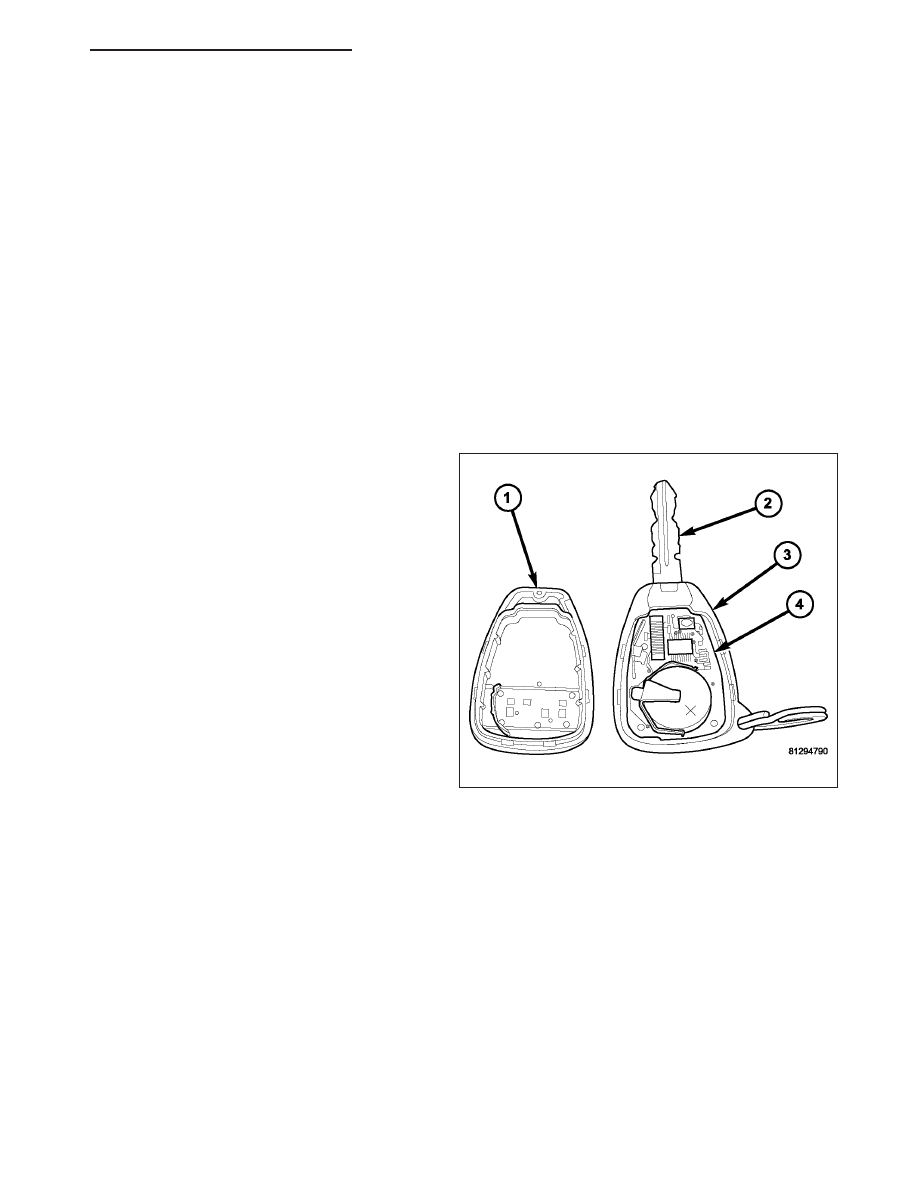Dodge Durango (HB). Manual - part 593

Each of these steps must be repeated and completed in their entirety for each additional Sentry Key that is to be
programmed. If the above steps are not completed in the given sequence, or within the allotted time, the SKREEM
will exit the Customer Learn programming mode and the programming will be unsuccessful. The SKREEM will also
automatically exit the Customer Learn programming mode if it sees a non-blank Sentry Key transponder when it
should see a blank, if it has already programmed eight (8) valid Sentry Keys, or if the ignition switch is turned to the
Off position for more than about fifty seconds.
NOTE: If an attempt is made to start the vehicle while in the Customer Learn mode (security indicator flash-
ing), the SKIS will respond as though the vehicle were being started with an invalid key. In other words, the
engine will stall after about two seconds of operation. No faults will be set.
NOTE: Once a Sentry Key has been programmed as a valid key to a vehicle, it cannot be programmed as a
valid key for use on any other vehicle.
TRANSPONDER KEY
DESCRIPTION
Each ignition key (2) used in the Sentry Key Immobi-
lizer System (SKIS) has a transponder chip included
on the circuit board (4) beneath the cover (1) of the
integral Remote Keyless Entry (RKE) transmitter (3).
In addition to having to be cut to match the mechani-
cal coding of the ignition lock cylinder and pro-
grammed for operation of the RKE system, each new
Sentry Key has a unique transponder identification
code that is permanently programmed into it by the
manufacturer, and which must be programmed into
the Sentry Key REmote Entry Module (SKREEM) to
be recognized by the SKIS as a valid key. The Sentry
Key transponder cannot be adjusted or repaired. If
faulty or damaged, the entire key and RKE transmitter
unit must be replaced.
OPERATION
When the ignition switch is turned to the On position, the Sentry Key REmote Entry Module (SKREEM) communi-
cates through its antenna with the Sentry Key transponder using a Radio Frequency (RF) signal. The SKREEM then
listens for a RF response from the transponder through the same antenna. The Sentry Key transponder chip is
within the range of the SKREEM transceiver antenna ring when it is inserted into the ignition lock cylinder. The
SKREEM determines whether a valid key is present in the ignition lock cylinder based upon the response from the
transponder. If a valid key is detected, that fact is communicated by the SKREEM to the Powertrain Control Module
(PCM) over the Controller Area Network (CAN) data bus, and the PCM allows the engine to continue running. If the
PCM receives an invalid key message, or receives no message from the SKREEM over the CAN data bus, the
engine will be disabled after about two seconds of operation. The ElectroMechanical Instrument Cluster (EMIC) will
also respond to the invalid key message on the CAN data bus by flashing the security indicator on and off.
Each Sentry Key has a unique transponder identification code permanently programmed into it by the manufacturer.
Likewise, the SKREEM has a unique Secret Key code programmed into it by the manufacturer. When a Sentry Key
is programmed into the memory of the SKREEM, the SKREEM stores the transponder identification code from the
Sentry Key, and the Sentry Key learns the Secret Key code from the SKREEM. Once the Sentry Key learns the
Secret Key code of the SKREEM, it is permanently stored in the memory of the transponder. Therefore, once a
Sentry Key has been programmed to a particular vehicle, it cannot be used on any other vehicle. (Refer to 8 -
ELECTRICAL/VEHICLE THEFT SECURITY - STANDARD PROCEDURE - TRANSPONDER PROGRAMMING).
HB
VEHICLE THEFT SECURITY - SERVICE INFORMATION
8Q - 91